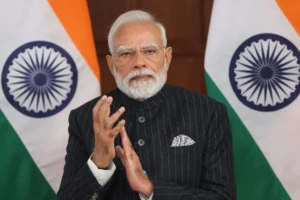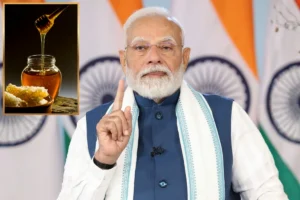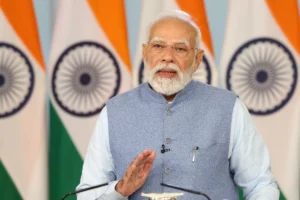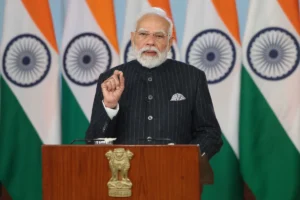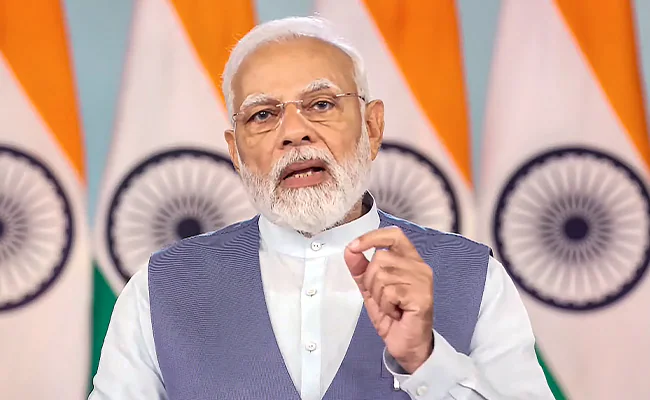
PM Narendra Modi
New Delhi: When the International Monetary Fund (IMF) called the Indian economy a “bright spot” in an otherwise dark immediate future for the world economy, it was met with cautious optimism by the decision-makers in India.
The truth is that PM Modi and his team had hunkered down in the immediate aftermath of the headwinds of the global pandemic and had charted an economic course for the country, which had the best facets of cautious fiscal prudence. That course has now proved to be a winner.
India’s recently released GDP numbers were an absolute showstopper, even beating the Government’s own estimate of 7 per cent. India’s GDP standing at a whopping 7.2 per cent, despite strong global financial headwinds makes it one of the fastest-growing emerging economies.
And with China stumbling in its recovery post the pandemic, India is set to grow at a faster pace as compared to its rivals.
A comprehensive report by US financial services firm, Morgan Stanley ‘How India has transformed in less than a decade’ is spot on in its nuanced analysis of the Indian economy. The report expressed confidence in India’s abilities to perform exceedingly well in the future as well.
From unprecedented revenue collections and discretionary spending, to record surges in exports and Foreign Direct Investment (FDI), from attaining unparalleled infra-development velocity to a sustained decrease in inflation indices, India is now reaping the benefits of her meticulously calibrated decisions in every aspect of the economy.
Morgan Stanley got it right with its headline, ‘This India is different from what it was in 2013’. What has India done that others haven’t in order to reach where it is today? ‘One of the coveted five economies of the world growing at the fastest rate’.
The most straightforward answer is ‘almost everything’. From strategizing long-term economic goals to effectively implementing reforms and measures, and from little tweaks for optimal results to complete overhauling of several frameworks, the brains behind the Indian economy have successfully delivered on both individual aspirations and the nation’s progress.
Charan Singh a fellow from EGROW Foundation a non-profit, multi-disciplinary public policy organization engaged in independent, high-quality research said, “If you look at the annual data, annual data as you rightly said we have grown at 7.2 per cent. The projection was 6.8 per cent. We have again exceeded the projection. That is something very positive. Where are we exceeding? We have done well on exports but the most important thing we have done well on is the gross fixed capital formation”.
From bringing ‘mom-and-pop’ stores under the purview of the government, in line with successful efforts towards formalization of the economy, the Modi government took off with an aim to ensure the tax base of the country was widened and the people at the lower economic ladder received enough opportunities for upward financial movement.
The formalization of the Indian economy ensured incentives, social security benefits, easy access to credit and financial services to those who complied and a complete makeover of the business environment of the country.
Manoranjan Sharma, an economist from Integrated Financial Omnibus Metrics Research of International Corporate Systems a SEBI-registered and RBI-accredited Credit Rating Agency said that “In this report, Morgan Stanley has highlighted certain very important factors such as supply-side policy reforms in relation to corporate taxes which have come to a level of about 26 per cent, formalization of the economies, GST collections have been coming at 1.5 lakh rupees every month on a consistent basis. Real estate significant changes are taking place.
Digitalization of the economies has occurred on a very large scale”.
Having navigated the initial phase of hardship where low-income business entities were affected, the long-term impact of government endeavors has started to bear fruit with nearly all businesses across the country contributing to the country’s financial system. And while the smaller businesses were tracked and taxed for the larger good of the country, India ensured her big businesses continued to flourish and came up with mechanisms that enabled a fearless business environment.
Atul Jindal another economist said while explaining India’s achievements in economic policy formation said, “There are many good changes for the Indian economy, like RERA (Real Estate Regulatory Authority), Bankruptcy Code, supply-side reforms, then good MNC culture, focus on FDI and of course, corporate profits”.
Businesses were deregulated, and excessive bureaucratic measures and red tape were dealt a heavy blow. India has also done away with retrospective tax laws. India has cultivated a favourable environment for investors. India received a record 84.8 billion USD in FDI including 7.1 billion in FDI equity inflows in the Fiscal Year of 2022.
India is also making great efforts to accelerate infrastructure development. From airways to railways and roadways, a swift expansion and upgradation are set to enhance the macroeconomic dividends of the country.
This makeover is also projected to significantly reduce India’s logistics expenditure from around 16 per cent to 10-12 per cent in the coming years. India’s digitalization endeavours have also gained global recognition with an increasing number of countries seeking to emulate her transaction model. The digitalization effort has extended services and incentives to even the most remote individuals and entities.
The government’s visionary ideas and effective implementation have cumulatively positioned India on the path to achieving remarkable growth. Some of the results are already available for everybody to see. India’s per capita income has witnessed a tremendous spike recently and is projected to grow to about 5,200 USD by 2032, according to Morgan Stanley.
Morgan Stanley estimates the inflation in the country will remain ‘benign and less volatile’, which would pave an obstruction-free growth passage for the country. India’s consumption basket is also increasing and the country is fast moving towards discretionary spending.
Subhrakant Panda the president of FICCI told ANI while explaining the reason for India beating its own economic growth estimations said that “this we believe is an outcome of structural reforms, of supportive policies, and of course, good governance which has led to India occupying its rightful place at the high table of global economies.
The Indian approach has sparked a fresh sense of optimism among Multinational Corporations which are looking towards the Indian market with great enthusiasm. From Apple Inc to Google, major corporations across sectors are expanding their footprints in India. Some say India is likely to become the most attractive investment destination around the world in the near future.
The country has already registered a significant leap in global rankings in terms of ease of doing business. The Indian market is thriving with a renewed vitality and the government is ensuring a sustained period of such economic growth, preventing any form of slowdown.
(ANI)
To read more such news, download Bharat Express news apps









